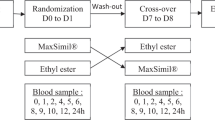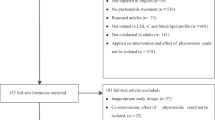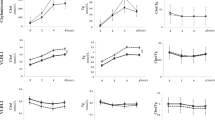Abstract
Background/Objectives:
Extrinsic phytosterols supplemented to the diet reduce intestinal cholesterol absorption and plasma low-density lipoprotein (LDL)-cholesterol. However, little is known about their effects on cholesterol metabolism when given in native, unpurified form and in amounts achievable in the diet. The objective of this investigation was to test the hypothesis that intrinsic phytosterols present in unmodified foods alter whole-body cholesterol metabolism.
Subjects/Methods:
In all, 20 out of 24 subjects completed a randomized, crossover feeding trial wherein all meals were provided by a metabolic kitchen. Each subject consumed two diets for 4 weeks each. The diets differed in phytosterol content (phytosterol-poor diet, 126 mg phytosterols/2000 kcal; phytosterol-abundant diet, 449 mg phytosterols/2000 kcal), but were otherwise matched for nutrient content. Cholesterol absorption and excretion were determined by gas chromatography/mass spectrometry after oral administration of stable isotopic tracers.
Results:
The phytosterol-abundant diet resulted in lower cholesterol absorption (54.2±2.2% (95% confidence interval 50.5%, 57.9%) vs 73.2±1.3% (69.5%, 76.9%), P<0.0001) and 79% higher fecal cholesterol excretion (1322±112 (1083.2, 1483.3) vs 739±97 mg/day (530.1, 930.2), P<0.0001) relative to the phytosterol-poor diet. Plasma lathosterol/cholesterol ratio rose by 82% (from 0.71±0.11 (0.41, 0.96) to 1.29±0.14 μg/mg (0.98, 1.53), P<0.0001). LDL-cholesterol was similar between diets.
Conclusions:
Intrinsic phytosterols at levels present in a healthy diet are biologically active and have large effects on whole-body cholesterol metabolism not reflected in circulating LDL. More work is needed to assess the effects of phytosterol-mediated fecal cholesterol excretion on coronary heart disease risk in humans.
This is a preview of subscription content, access via your institution
Access options
Subscribe to this journal
Receive 12 print issues and online access
$259.00 per year
only $21.58 per issue
Buy this article
- Purchase on Springer Link
- Instant access to full article PDF
Prices may be subject to local taxes which are calculated during checkout


Similar content being viewed by others
References
Agren JJ, Tvrzicka E, Nenonen MT, Helve T, Hanninen O (2001). Divergent changes in serum sterols during a strict uncooked vegan diet in patients with rheumatoid arthritis. Br J Nutr 85, 137–139.
Davis Jr HR, Hoos LM, Tetzloff G, Maguire M, Zhu LJ, Graziano MP et al. (2007). Deficiency of Niemann-Pick C1 Like 1 prevents atherosclerosis in ApoE−/− mice. Arterioscler Thromb Vasc Biol 27, 841–849.
Demonty I, Ras RT, van der Knaap HCM, Duchateau GSMJE, Meijer L, Zock PL et al. (2009). Continuous dose-response relationship of the LDL-cholesterol-lowering effect of phytosterol intake. J Nutr 139, 271–284.
Denke MA (1995). Lack of efficacy of low-dose sitostanol therapy as an adjunct to a cholesterol-lowering diet in men with moderate hypercholesterolemia. Am J Clin Nutr 61, 392–396.
Devaraj S, Autret BC, Jialal I (2006). Reduced-calorie orange juice beverage with plant sterols lowers C-reactive protein concentrations and improves the lipid profile in human volunteers. Am J Clin Nutr 84, 756–761.
Expert Panel on Detection (2001). Executive summary of the third report of the national cholesterol education program (NCEP) Expert Panel on Detection, Evaluation, and Treatment of High Blood Cholesterol in Adults (Adult Treatment Panel III). JAMA 285, 2486–2497.
Food and Agricultural Organization/World Health Organization/United Nations University (1985). Energy and protein requirements. Report of a Joint FAO/WHO/UNU Expert Consultation. WHO: Geneva, Switzerland, pp 1–206.
Friedewald WT, Levy RI, Fredrickson DS (1972). Estimation of the concentration of low-density lipoprotein cholesterol in plasma, without use of the preparative ultracentrifuge. Clin Chem 18, 499–502.
Harris JA, Benedict FG (1919). A Biometric Study of Basal Metabolism in Man Carnegie. Institute of Washington: Washington, DC.
Howell TJ, MacDougall DE, Jones PJ (1998). Phytosterols partially explain differences in cholesterol metabolism caused by corn or olive oil feeding. J Lipid Res 39, 892–900.
Joseph SB, McKilligin E, Pei L, Watson MA, Collins AR, Laffitte BA et al. (2002). Synthetic LXR ligand inhibits the development of atherosclerosis in mice. Proc Natl Acad Sci USA 99, 7604–7609.
Lichtenstein AH, Appel LJ, Brands M, Carnethon M, Daniels S, Franch HA et al. (2006). Diet and lifestyle recommendations revision 2006: a scientific statement from the American Heart Association Nutrition Committee. Circulation 114, 82–96.
Lin X, Ma L, Racette SB, Anderson Spearie CL, Ostlund Jr RE (2009). Phytosterol glycosides reduce cholesterol absorption in humans. Am J Physiol Gastrointest Liver Physiol 296, G931–G935.
Lutjohann D, Meese CO, Crouse III JR, von Bergmann K (1993). Evaluation of deuterated cholesterol and deuterated sitostanol for measurement of cholesterol absorption in humans. J Lipid Res 34, 1039–1046.
Matthan NR, Pencina M, LaRocque JM, Jacques PF, D’Agostino RB, Schaefer EJ et al. (2009). Alterations in cholesterol absorption/synthesis markers characterize Framingham offspring study participants with CHD. J Lipid Res 50, 1927–1935.
Miettinen TA, Tilvis RS, Kesäniemi YA (1989). Serum cholestanol and plant sterol levels in relation to cholesterol metabolism in middle-aged men. Metabolism 38, 136–140.
Nair PP, Turjman N, Kessie G, Calkins B, Goodman GT, Davidovitz H et al. (1984). Diet, nutrition intake, and metabolism in populations at high and low risk for colon cancer. Dietary cholesterol, beta-sitosterol, and stigmasterol. Am J Clin Nutr 40, 927–930.
Nestel P, Cehun M, Pomeroy S, Abbey M, Weldon G (2001). Cholesterol-lowering effects of plant sterol esters and non-esterified stanols in margarine, butter and low-fat foods. Eur J Clin Nutr 55, 1084–1090.
Normén L, Dutta P, Lia A, Andersson H (2000). Soy sterol esters and beta-sitostanol ester as inhibitors of cholesterol absorption in human small bowel. Am J Clin Nutr 71, 908–913.
Ostlund Jr RE, Spilburg CA, Stenson WF (1999). Sitostanol administered in lecithin micelles potently reduces cholesterol absorption in humans. Am J Clin Nutr 70, 826–831.
Ostlund Jr RE (2002). Phytosterols in human nutrition. Annu Rev Nutr 22, 533–549.
Ostlund Jr RE, Racette SB, Okeke A, Stenson WF (2002). Phytosterols that are naturally present in commercial corn oil significantly reduce cholesterol absorption in humans. Am J Clin Nutr 75, 1000–1004.
Ostlund Jr RE, Racette SB, Stenson WF (2003). Inhibition of cholesterol absorption by phytosterol-replete wheat germ compared with phytosterol-depleted wheat germ. Am J Clin Nutr 77, 1385–1389.
Peterson DW (1951). Effect of soybean sterols in the diet on plasma and liver cholesterol in chicks. Proc Soc Exp Biol Med 78, 143–147.
Piironen V, Lampi AM (2004). Occurrence and levels of phytosterols in foods. In: Dutta PC (ed). Phytosterols as Functional Food Components and Nutraceuticals. Marcel Dekker, Inc.: New York, p 2.
Piironen V, Lindsay DG, Miettinen TA, Toivo J, Lampi A-M (2000). Plant sterols: biosynthesis, biological function and their importance to human nutrition. J Sci Food Agric 80, 939–966.
Pollak OJ (1953). Reduction of blood cholesterol in man. Circulation 7, 702–706.
Racette SB, Lin X, Lefevre M, Spearie CA, Most MM, Ma L et al. (2010). Dose effects of dietary phytosterols on cholesterol metabolism: a controlled feeding study. Am J Clin Nutr 91, 32–38.
Racette SB, Spearie CA, Phillips KM, Lin X, Ma L, Ostlund Jr RE (2009). Phytosterol-deficient and high-phytosterol diets developed for controlled feeding studies. J Am Diet Assoc 109, 2043–2051.
Schoenhagen P, Tuzcu EM, Apperson-Hansen C, Wang C, Wolski K, Lin S et al. (2006). Determinants of arterial wall remodeling during lipid-lowering therapy: serial intravascular ultrasound observations from the reversal of atherosclerosis with aggressive lipid lowering therapy (REVERSAL) trial. Circulation 113, 2826–2834.
Terasaka N, Hiroshima A, Koieyama T, Ubukata N, Morikawa Y, Nakai D et al. (2003). T-0901317, a synthetic liver X receptor ligand, inhibits development of atherosclerosis in LDL receptor-deficient mice. FEBS Lett 536, 6–11.
Turley SD, Dietschy JM (2003). The intestinal absorption of biliary and dietary cholesterol as a drug target for lowering the plasma cholesterol level. Prev Cardiol 6, 29–33, 64.
US Department of Health and Human Services and US Department of Agriculture. Dietary Guidelines for Americans, (2005): US Government Printing Office: Washington, DC.
US Food and Drug Administration (2008). Code of Federal Regulations. Title 21, vol. 2—Food and Drugs.
Warnick GR, Benderson J, Albers JJ (1982). Dextran sulfate-Mg2+ precipitation procedure for quantification of high-density lipoprotein cholesterol. Clin Chem 28, 1379–1388.
Acknowledgements
This work was supported by NIH grants R01 HL050420, MO1 RR-00036, RR-00954, P60-DK020579-30 and P30 DK056341. We thank Robin Fitzgerald and Michele Burton for excellent technical assistance.
Author information
Authors and Affiliations
Corresponding author
Ethics declarations
Competing interests
Washington University and Dr Ostlund have a financial interest in Lifeline Technologies, Inc., a startup company commercializing emulsified phytosterols. (Emulsified phytosterols and Lifeline products were not used in this work.) The remaining authors declare no conflict of interest.
Rights and permissions
About this article
Cite this article
Lin, X., Racette, S., Lefevre, M. et al. The effects of phytosterols present in natural food matrices on cholesterol metabolism and LDL-cholesterol: a controlled feeding trial. Eur J Clin Nutr 64, 1481–1487 (2010). https://doi.org/10.1038/ejcn.2010.180
Received:
Revised:
Accepted:
Published:
Issue Date:
DOI: https://doi.org/10.1038/ejcn.2010.180
Keywords
This article is cited by
-
A combination of omega-3 and plant sterols regulate glucose and lipid metabolism in individuals with impaired glucose regulation: a randomized and controlled clinical trial
Lipids in Health and Disease (2019)
-
Comparison of volatile and non-volatile compounds as antioxidant indicators of water spinach (Ipomoea aquatic Forsk.)
Journal of the Korean Society for Applied Biological Chemistry (2012)
-
Glycosidic Bond Cleavage is Not Required for Phytosteryl Glycoside‐Induced Reduction of Cholesterol Absorption in Mice
Lipids (2011)



